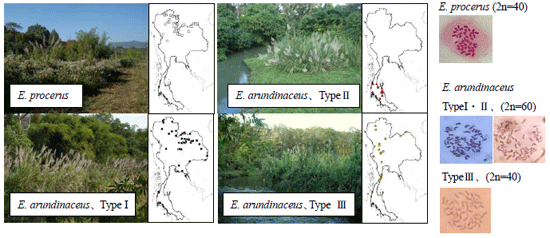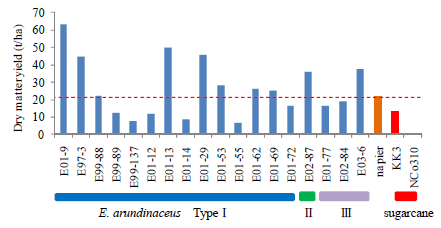Evaluation and classification of Erianthus germplasm in Thailand
Description
To relieve tight supply of food and energy in the world, it is important to develop high biomass crops for sugar and fiber, which show much higher production in adverse environment. The genus Erianthus, one of the ‘Saccharum complex’, has been paid a lot of attention as a breeding material for sugarcane improvement and as raw material for cellulose production since it has high adaptability to adverse environments, especially drought. From 1997 to 2010, JIRCAS and the Khon Kaen Field Crops Research Center (KKFCRC) in Thailand collected 151 Erianthus accessions from all over Thailand and preserved these in the KKFCRC field. In this project we evaluated and classified our collection of Thai Erianthus accessions for effective utilization in sugarcane breeding.
A total of 21 morphological characteristics, flowering phenology and cytological and biogeographical data were examined on 108 Thai Erianthus accessions, which were collected from 1997 to 2003. In the viewpoint of the present plant taxonomy, Erianthus accessions were classified to two species, E. arundinaceus and E. procerus. Further, E. arundinaceus was considered to be divided into three types (namely, Type I, II and III) (Fig. 1, Table 1).
E. procerus is distributed west to north and in the northern parts of northeast Thailand. Chromosome number is 2n=40, and it mainly grows on the open slopes of hills and mountains, field sides, roadsides, etc. It is difficult to propagate vegetatively because of its small buds and none to a few number of root primordia. There’s too much wax and no hair on the leaf sheath except the ridges of the leaf sheath and around the ligule. Flowering time starts from December to January (Fig. 1, Table 1).
E. arundinaceus Type I is widely distributed in the Indochina peninsula. Chromosome number is 2n=60, and it also grows on the open slopes of hills and mountains, field sides, roadsides, etc. It shows a wider variation in the quantity of hair and wax at the back of the leaf sheath, but there is no accession without hair. Germination of bud is not so bad, but some accessions show poor ability in vegetative propagation. Flowering time occurs in November to January (Fig. 1, Table 1).
E. arundinaceus Type II is distributed in the southern part of Thailand. Chromosome number is 2n=60, and it grows along river banks, stream beds and swamps. It has big buds and a higher number of root primordia. There’s none to a few hair and a lot of wax present on the leaf sheath. Flowering time occurs in December (Fig. 1, Table 1).
E. arundinaceus Type III is distributed in the western to northern parts of Thailand and along the Mekong River in the northeast. Chromosome number is 2n=40, and it grows along the riverbanks and stream beds. They are easily propagated vegetatively due to well-developed buds and root primordia. No hair and wax on leaf. Flowering time occurs in September and lasts until October (Fig. 1, Table 1). Dry matter yield of some E. arundinaceus accessions at the 3rd ratooning were higher than in conventional sugarcane varieties and napier grass (Fig. 2).
Erianthus is a promising material for sugarcane improvement and as a raw material for cellulose production. These results will contribute to the Erianthus collection, preservation and effective utilization efforts in Thailand.
Figure, table
-
Fig. 1.
Photos of natural habitats in Thailand, geographical distribution and chromosomes of E. procerus and three types of E. arundinaceus. -
Table 1. Characteristics of E. procerus and three types of E. arundinaceus
-
Fig. 2.
Dry matter yield of some E. arundinaceus accessions (Type I, II, III) at 3rd ratooning in the KKFCRC field.
- Affiliation
-
Japan International Research Center for Agricultural Sciences Tropical Agriculture Research Front
- Classification
-
Administration B
- Term of research
-
FY2002~2010
- Responsible researcher
-
Tagane Shuichiro ( Tropical Agriculture Research Front )
Sugimoto Akira ( Tropical Agriculture Research Front )
KAKEN Researcher No.: 30414840Teraiima Yoshifumi ( Tropical Agriculture Research Front )
EGAWA Yoshinobu ( Tropical Agriculture Research Front )
Ishiki Koshun ( Tropical Agriculture Research Front )
MIERUKA ID: 001730SATO Mitsunori ( Kagoshima Prefectural Institute for Agricultural Development )
Irei Shin ( Okinawa Prefectural Agricultural Research Center )
PONRAGDEE Werapon ( Khon Kaen Field Crop Research Center )
SANSAYAWICHAI Taksina ( Khon Kaen Field Crop Research Center )
TIPPAYAWAT Amarawan ( Khon Kaen Field Crop Research Center )
- ほか
- Publication, etc.
-
Tagane et al. (2011) Cytological study of Erianthus procerus and E. arundinaceus (Gramineae) in Thailand. Cytologia (in printing).
- Japanese PDF
-
2010_seikajouhou_A4_ja_Part20.pdf316.62 KB



